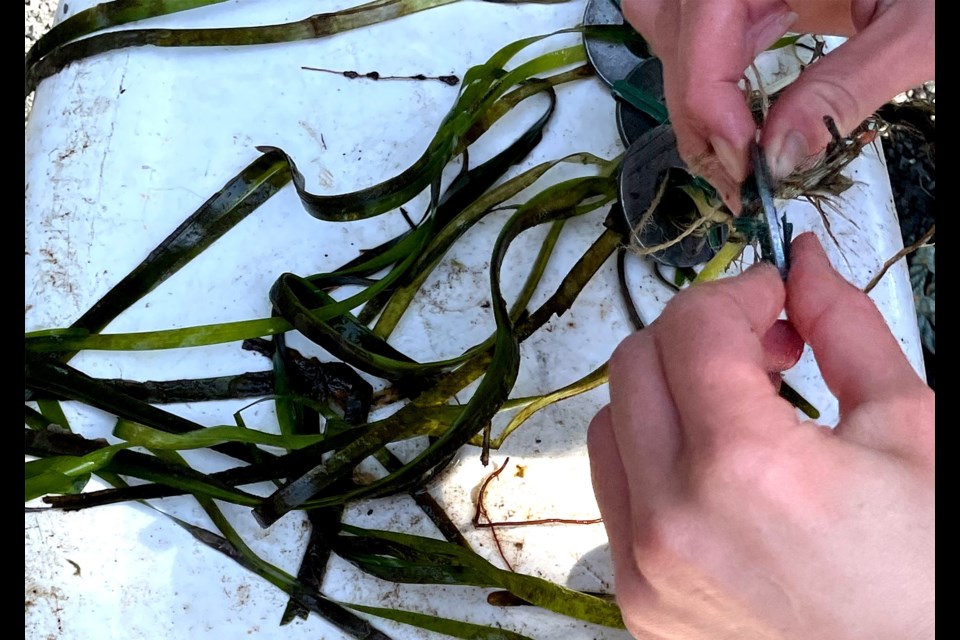Tsleil-Waututh Nation School students took to the shores of Whey-ah-wichen, Cates Park in North Vancouver this week to immerse themselves in the ways of planting and restoring eelgrass.
Around 16 students got their hands slimy while learning about the importance of the marine plant and how TWN works to protect Burrard Inlet in its role as stewards of the land at one of the community’s most sacred traditional sites.
But it isn’t uncommon for students to be outdoors. In fact, that’s where they do the majority of their learning.
The First Nations school, located on Tsleil-Waututh’s reserve on the North Shore, puts an emphasis on experiential learning, and the new eelgrass initiative led by team members from the TWN’s Treaty, Lands and Resources department and the Sea Change Society is just one of the many ways students are able to take part in hands-on, land-based learning.
“We're always outdoors,” the school’s vice-principal Sarah Martz said. “On Tuesday, in the morning we were in the forest doing wilderness survival training. Students were learning how to make fires out in nature and build shelters, and then they had lunch, and then we went down to plant the eelgrass.”
The TWN School grew from 10 students to 60, from kindergarten to Grade 12, after the pandemic struck and families in the community wanted their children closer to home. Having a bigger school had been a vision for TWN for many years, said Martz, adding that COVID-19 had propelled them into making it a reality for their members.
Angela George, director of community development for TWN, said the school is offering hands-on, land-based culturally immersed programming, “that can really inspire the students to learn innovatively and in their own way.”
The school’s programming is all about decolonizing education strategies.
“Land-based learning is really weaving together the best of academic knowledge and Western ways of learning with our traditional ways of learning out on the land, immersed in the activity," George said. “Learning by doing. It is very project-based.
“Rather than opening up a textbook, let's – wherever possible – roll up our sleeves and get our hands right in it and feet on the ground.”
Students help to restore Burrard Inlet ecosystem
The new eelgrass initiative is a perfect example of this.
Eelgrass is a marine flowering plant, not a seaweed, that grows in salty tidal waters, preferring shallow, muddy or sandy areas and is vital to the Burrard Inlet marine habitat, explained Lindsey Ogston, TWN environmental programs manager. She noted that eelgrass habitats throughout the territory are under threat from development.
In preparation for the start of the eelgrass planting project, Martz said the topic had been woven into the school’s trans-disciplinary curriculum in a variety of ways and students had looked at authentic resources on eelgrass and learned about its importance from both a cultural and scientific perspective.
“By the time my students went down to the water to participate in the hands-on experience, they had all this wealth of knowledge already,” she said.
Eelgrass can grow from seeds that are released from tall underwater flowers that float along through the water column, Ogston said. For the restoration project, the shoots were collected in baskets by divers, and kept in big buckets of cool seawater and then brought ashore.
This is where the students come in. They helped TWN staff carefully prepare the shoots to be replanted by divers by attaching each one to a metal washer, which weighs the rhizome down in its new muddy substrate until it has a chance to establish.
Ogston said the work to restore eelgrass beds is important for the health of Burrard Inlet and Indian Arm for many reasons, including reducing erosion, combating sea level rise and shoreline hardening, improving water quality, enhancing habitat and acting as a carbon sink. It also provides habitat for many species.
“It’s native to the Burrard Inlet and the inlet is so sacred to the Tsleil-Waututh people,” George added. “Our story of creation outlines that our first grandmother was born from the inlet. So, it's the womb of the earth and the Tseil-Waututh people come from there.
“The eelgrass is so important to the habitat and the overall health of the inlet. So TLR and the TWN have been fighting to protect the inlet because it's such an integral part of who we are.”
And, it is all part of a much bigger picture.
“Restoring the health of the inlet restores the health of the people,” George explained.
“To have our land-based education programming involved is really a part of that whole larger vision.
“If we believe that, to the core, health is our genuine wealth, then having that connection to the land, connection to our ancient knowledge, and ways of knowing, ways of teaching, ways of learning, reconnecting our students in all of our educational programming to that is very, very vital.”
Elisia Seeber is the North Shore News’ Indigenous and civic affairs reporter. This reporting beat is made possible by the Local Journalism Initiative.



